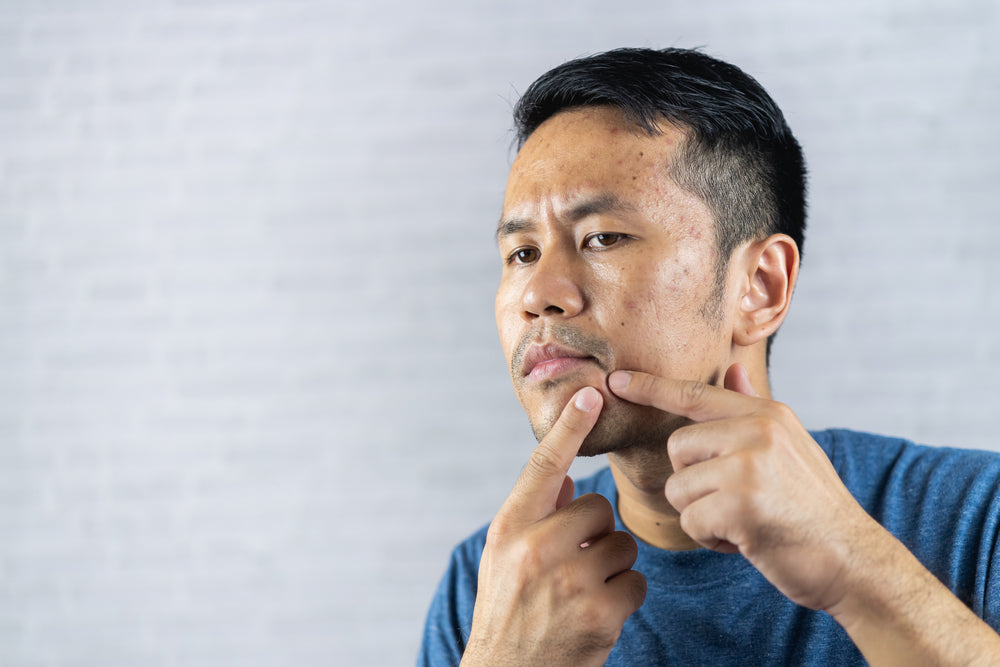Acne Under Chin: Causes, Treatments, & More

Acne can form almost anywhere on the body. It’s not good to see regardless of its location, but it can be particularly burdensome under the chin.
Here’s what to know about this particular type of acne and what you can do about it.
What Causes Acne Under the Chin
Acne under the chin forms the same way as any other pimples. Acne develops as a result of oil on the skin, or sebum, trapping bacteria and other debris in your pores.
This creates inflammation, and the result is a raised red bump on the skin. It’s troublesome under the chin because men form beards there, and it’s not fun to have zits covered up by all that hair.
Other factors can influence the production of sebum, which are described in more detail below.
1. Hormonal Acne
Hormonal fluctuations can impact how much oil your skin produces. This is why teenagers tend to get acne. It’s due to the fact their in a state of hormonal flux, so their skin goes out of whack.
2. Stress
When your body is in a state of panic, it releases various hormones, including androgens and cortisol. These hormones increase your skin’s oil production, exacerbating the presence of any acne.
3. Touching Your Face
Your hands may be filthy. When you touch your face, you may inadvertently transfer dirt and other debris onto your skin’s pores.
With too much sebum, it can trap that debris onto the skin, inflamming it. This can lead to pimples.
4. Sports Equipment
The same principle applies to sporting equipment you may have to wear. Helmets and chin straps may also carry bacteria and dirt you don’t want impacting your skin.
5. Rosacea
Untreated rosacea causes your body to get out of its natural state. It reacts poorly to the presence of bacteria, leading to acne production.
Types of Chin Acne
Acne can look different depending on its severity and where on the body it forms. For the chin, here are the main culprits to look out for.
Blackheads
Blackheads are noninflammatory types of acne that develop when pores become clogged with sebum and dead skin cells. The pore remains open, exposing it to oxygen, which is what gives it its black aesthetic.
Nodules
Nodular acne is a more severe form. It’s inflammatory and causes firm, painful lumps to develop under the skin. This may cause red bumps to form on the surface.
You need treatment from a healthcare provider to deal with nodular acne, as you’re unable to treat it yourself. You may need topical creams or prescription oral medication to deal with it.
Cystic Acne
Your chin has more oil glands than other areas of your skin, which is why acne is prone to developing there. This includes cystic acne, which again, requires a professional’s help.
Pustules
Pustules are typically associated with rosacea. These are solid, inflamed bumps that tend to be conical in shape.
How to Treat Acne Under Chin
To begin, you should wash your face at least twice a day if you don’t already. This helps remove excess oil from the skin, greatly reducing the likelihood of sebum trapping debris in your pores.
In fact, you should develop a full-scale skincare regimen to keep your skin looking its best. If you still notice pimples forming, then you can start with at-home remedies, such as aloe vera. Additionally, drinking more water can help keep your skin hydrated.
The next step is to use over-the-counter products designed to help with acne. Only after you have exhausted those options should you speak with a dermatologist about getting heavier-duty items to tackle your acne.
The Takeaway
Acne under the chin isn’t fun, especially if you’re a man with a beard. However, like acne anywhere else, there are steps you can take to address it.
References:
Cobb, Cynthia DNP, APRN, WHNP-BC, FAANP. “What causes acne on the jawline?” 16 Mar. 2018. https://www.medicalnewstoday.com/articles/321218
Sinrich, Jenn and Miller, Korin. “What to Know About Hormonal Acne—and How to Get Rid of It.” 5 Oct. 2021. https://www.self.com/story/hormonal-acne


Leave a Comment